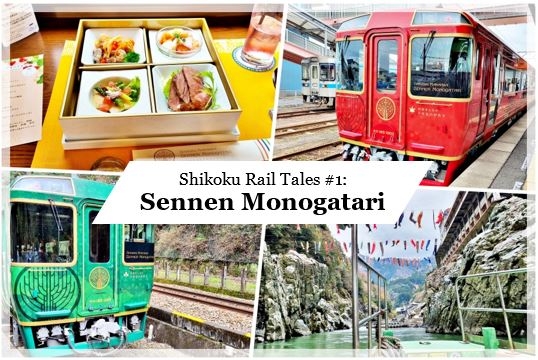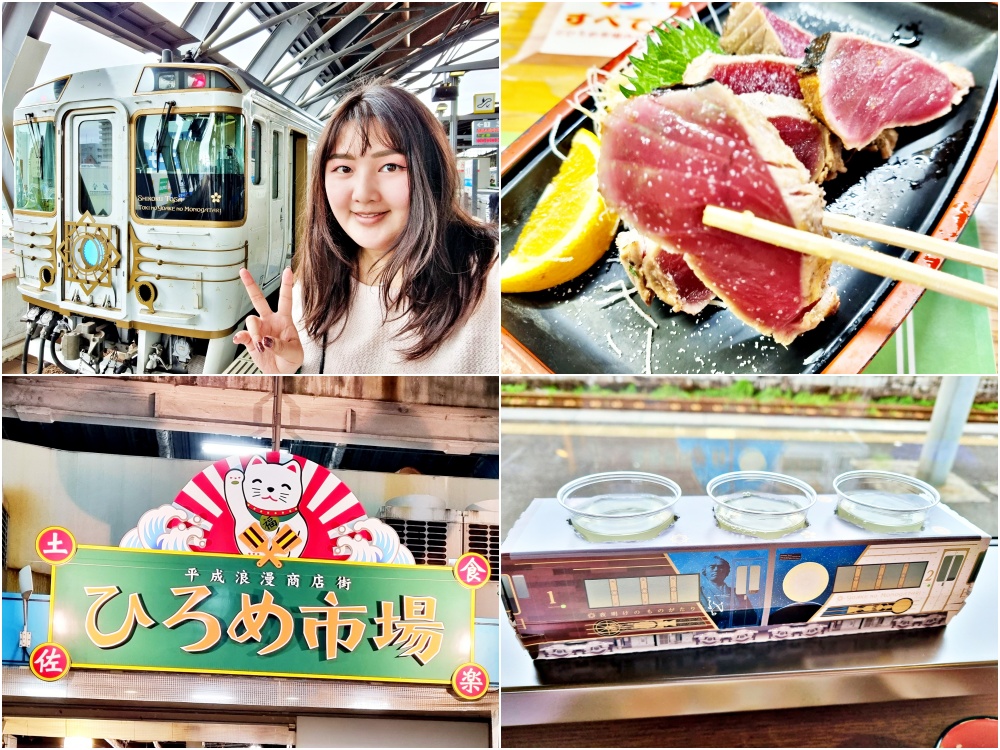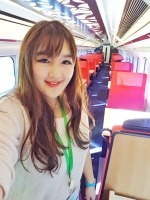Shikoku Rail Tales #1: Shikoku Mannaka Sennen Monogatari and going around Oboke Gorge

The smallest of Japan's four main islands, Shikoku (四国) has a name that means "four kingdoms", and is home to four prefectures filled with rich culture, breathtaking nature, delectable dishes, and more: Kagawa Prefecture (香川県), Tokushima Prefecture (徳島県), Kochi Prefecture (高知県), and Ehime Prefecture (愛媛県).
Despite being relatively unknown to non-Japanese with less than 1% of foreign tourists visiting, Shikoku is a wonderful destination, and definitely worth a spot on your Japan bucket list! Having visited all of Japan's 47 prefectures, Shikoku is a place I'd love to visit again and spend more time exploring.

Shikoku’s three Monogatari sightseeing trains. (Image credit: Carissa Loh)
In this new series, Shikoku Rail Tales, we'll explore travelling around Shikoku via rail, specifically taking a look their three Monogatari sightseeing trains:
- Shikoku Mannaka Sennen Monogatari (四国まんなか千年ものがたり)
- Shikoku Tosa Toki No Yoake No Monogatari (志国土佐 時代の夜明けのものがたり)
- Iyonada Monogatari (伊予灘ものがたり)
The train with a thousand-year tale

The Shikoku Mannaka Sennen Monogatari. (Image credit: photoAC)
"Monogatari" (物語) means "tale", and each train tells the tale of the region it travels through. To kick off this series, let's begin with the Shikoku Mannaka Sennen Monogatari. Often referred to by its shorter name of Sennen Monogatari, which means "Thousand-year tale", this train pays homage to Shikoku's long history. Shikoku is the birthplace of the legendary monk, Kūkai, and is known for the 88 Temple Pilgrimage (遍路 henro), which includes temples and sacred sites that Kūkai was believed to have trained at over 1,000 years ago.
The Sennen Monogatari is meant to be a sightseeing train for adults to enjoy a stylish excursion through Shikoku’s scenic mountains and valleys, while pondering and thinking about its history. Running on the Dosan Line (土讃線) mainly on weekends and holidays, the train makes one round-trip per day of operation between Tadotsu Station (多度津駅) in Kagawa Prefecture and Oboke Station (大歩危駅) in Tokushima Prefecture.
The interior

Inside the train. (Image credit: Carissa Loh)
For this trip, I took the outbound train, which departed Tadotsu Station at 10:19, and the journey to Oboke Station would take approximately 2.5 hours. The Sennen Monogatari is a beautiful three-car train, with wooden furnishings and decorated in colours and themes of different seasons, meant to embody Shikoku's four distinct seasons. Car 1 is spring, featuring a verdant green; Car 2 is summer and winter, with a mix of greens and blues; and Car 3 is autumn, featuring shades of red and orange.
The Welcome Lounge

Drinks at Lounge Taiju. (Image credit: Carissa Loh)
After departing Tadotsu Station we made a short stop at Kotohira Station (琴平駅), where we were treated to welcome drinks at a lounge, which consisted of pumpkin soup and a sparkling drink with cherry blossom petals.

Kotohira Shrine is a pleasant day trip to make while in Kagawa Prefecture. (Image credit: Carissa Loh)
The Dosan Line passes by many temples, including Zentsuji, said to be the birthplace of Kūkai. Other than Tadotsu Station, you can also choose to board from Kotohira Station, home to the well-known Kotohira Shrine (金刀比羅宮Kotohira-gū)―also known as Konpirasan―famed for its arduous 1,368-step climb to the inner shrine. I visited this place the day before, and highly recommend it if you’re in Shikoku. It gets quieter, with less people the further up you go, and the atmosphere is serene and mystical.
The marvellous meal

Itadakimasu! (Image credit: Carissa Loh)
A highlight of the Monogatari trains is the exquisite meals served on board. For the outbound route of the Sennen Monogatari, guests are served a Western-style meal using local ingredients from Kagawa. For the inbound route, guests will be served a Japanese-style meal.

Close up of the food. (Image credit: Carissa Loh)
Kagawa Prefecture, which bears the old name of Sanuki (讃岐), is famous for its olives, and this was featured in the meal in the cold dishes of Sanuki Olive Chicken (讃岐オリーブ地鶏) and roasted Sanuki Olive Beef (讃岐オリーブ牛). Both dishes showcased the meat of chickens and cows that have been fed a diet of local olives. There was also a generous portion of marinated seafood (my favourite), and a salad, which included Kagawa-grown bamboo shoots (タケノコ takenoko).

A short photo-stop at Tsubojiri Staion. (Image credit: Carissa Loh)
At around 11:30, we made a short stop at Tsubojiri Station (坪尻駅). This secluded, unmanned station is tucked away in the mountains, and can only be reached by train, as there are no roads that lead there. There were a few trees nearby that were starting to bloom, so we spent the time taking photos with the commemorative board and enjoying the flowers.

Meal with a view. (Image credit: Carissa Loh)
For the warm dish, we were served buttered Kagawa-grown rice together with a Sanuki Olive Pork tomato stew, which used―you guessed it―meat of pigs which have been fed on local olives.

Commemorative photo at Awa-Ikeda Station. (Image credit: Carissa Loh)
The train made a very brief stop at Awa-Ikeda Station (阿波池田駅), where passengers could don a driver’s hat and commemorative happi (法被) coat to take photos with the train. We received a hearty send-off from the station staff and local preschool children, who had gathered to see the train.

Coffee to end the meal. (Image credit: Carissa Loh)
Back on the train, to end off the meal coffee was served, along with simple desserts of wasanbon (和三盆) cookies and madeleines. As a memento, passengers also got a commemorative postcard with an image of the train.

Views from the train window. (Image credit: Carissa Loh)
The train passed by the Yoshino River (吉野川), Shikoku’s second largest river, overlooking the gorge-ous scenery of the Oboke and Koboke Gorges.
Exploring Oboke

Warm welcome at Oboke Station. (Image credit: Carissa Loh)
As we approached the terminal station, Oboke Station, we were warmly greeted by enthusiastic volunteers waving and dancing, welcoming us to Oboke. The train arrived at 12:47, and I had about 4 hours to explore Oboke Gorge until my next train arrives.

Exiting Oboke Station. (Image credit: Carissa Loh)
Given the infrequent public transport and time required to get to the destinations I had in mind, this was just the right amount of time. I took the 13:10 bus from Oboke Station to Iya Valley (祖谷), as I wanted to check out the Kazurabashi Vine Bridge (祖谷のかずら橋 Iya no Kazurabashi).

Crossing the famous vine bridge. (Image credit: Carissa Loh)
The 45m-long Kazurabashi Bridge is suspended 14m above the river, and is made by hand out of vines, rebuilt every 3 years. I had wanted to visit this place for the longest time, but until my visit, I never realised how far apart each step of the bridge is.
My feet are pretty big, so looking at the spaces between each step and walking across the bridge is more fear-inducing than it looks! But the views from the bridge were incredible, with the sound of the flowing river and picturesque mountains added to the “hidden valley” experience.

Enjoy a scenic and leisurely boat ride. (Image credit: Carissa Loh)
After crossing the bridge, I headed back to the bus stop and took the 14:16 bus to the Oboke Gorge pier, in order to take a ride on the Oboke Gorge Sightseeing Boat. This 30-minute pleasure boat ride brings you along the scenic river valley, and lets you get a closer look at the towering rocks and cliffs. The open-air boat also lets you enjoy the fresh breeze, and gives an unobstructed view or the surroundings.

Cherry blossoms at Oboke Station. (Image credit: Carissa Loh)
When I was done with the boat ride, I walked back to Oboke Station, where a surprise awaited me: the station had stairs leading to a platform overlooking the river, with many cherry blossom trees planted. Lucky for me, they were blooming during my visit, and I got to enjoy the beautiful spring scenery while I waited for my train.
Onward to Kochi

Heading to Kochi in style. (Image credit: Carissa Loh)
I was going to take a train to Kochi Station (高知駅), where I would be taking the next Monogatari train, the Shikoku Tosa Toki No Yoake No Monogatari, the following day. To my delight, I got another surprise: the train that arrived was a specially decorated Anpanman train! (アンパンマン列車)
Did you know? The creator of Anpanman, Yanase Takashi, was born in Kochi.

Preview for the next chapter. (Image credit: Carissa Loh)
Finally, after a 1-hour ride, I reached my final destination for the day, Kochi. Stay tuned for the next article in this series, where we explore Kochi and its scrumptious delicacies, before taking a ride of the Shikoku Tosa Toki No Yoake No Monogatari!
Header image credit: Carissa Loh
Related Articles






